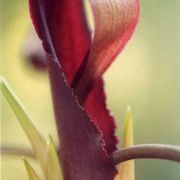|
|


| ||||||||||||||||||||||||||||||||||||||||||||||||||||||||||||||||||||||||||||||||||||||||||||||||||||||||||||||||||||||||||||||||||||||||||||||||||||||||
|
The Genus Biarum by Peter Boyce
Biarum
Schott nom. cons. in Schott & Endlicher, Melet. Bot. 17 (1832)
& Syn. Aroid. 6 (1856) & Gen. Aroid. t.7 (1858) & Prodr. Syst.
Aroid. 60-64 (1860); Pfeiffer, Nomen. Bot. 1(1): 403-404 (1873); Engler in
A. & C. DC., Monog. Phanerog. 2: 571-580 (1879) & in Engler &
Prantl., Die Natürl. Pflanzenfam. 149 (1889) & in Engler, Pflanzenr.
73(IV.23F): 132-143 (1920); Riedl in Aroideana 3(1): 24-31 (1980). Type: B.
tenuifolium (L.) Schott. Homaïd Adans., Fam. Pl. 2:470 (1763) in syn. nom. rejic.; Pfeiffer, Nomen. Bot. 1(2): 1658 (1874). Type: H. tenuifolium (L.) Adans. Ischarum Schott & Kotschy, Oesterr. Bot. Wochen. 4: 81 (1854); Schott, Syn. Aroid. 6-8 (1856) & Gen. Aroid. t.10 (1858) & Prod. Syst. Aroid. 65-70 (1860); Pfeiffer, Nomen. Bot. 1(2):1764 (1874). Type: I. bovei (Blume) Schott (See Nicolson 1967). Leptopetion Schott, Gen. Aroid. t.8 (1858) & Prodr. Syst. Aroid.
64 (1860). Type: L. alexandrinum
(Boiss.) Schott. Cyllenium Schott, Gen. Aroid. t.9 (1858) & Prodr. Syst. Aroid.
64-65 (1860). Type: C. spruneri
(Boiss.) Schott. Stenurus Salis., Gen. Pl. 5 (1866). Type: S. tenuifolium (L.) Salis. Homaida Adans. emend O. Kuntze, Rev. Gen. Pl. 2: 742 (1891). Type: H. tenuifolium (L.) Adans. emend O. Kuntze. Dwarf tuberous stemmed herbs. Tuber dorso-ventrally compressed-discoid to ± globose, encased basally by remains of the previous season's tuber, growth point central, peripheral adventitious buds none to many, usually giving rise to independent tubers, tuber apex coated with moderate to copious amounts of waxy farina and bearing the remains of the previous season's cataphylls; roots simple, emitted in a ring around the growth point, contractile or feeding; contractile roots fusiform, usually thick, feeding roots slender, cylindrical. Foliage hysteranthous, occasionally synanthous, rarely proteranthous, petiolate., petiole sometimes ± subterranean, leaves erect or, rarely, reflexed; petioles enclosed proximally by several cataphylls, the inner papery and the outer fibrous, these often emerging above ground and encasing the basal part of the aerial shoot, petioles terete proximally, canaliculate and expanded into a membranous wing distally, petioles enclosing one another, forming a weakly defined aerial pseudostem in some species; leaf lamina linear, lanceolate, elliptic-oblong or spathulate, decurrent, ± cuneate, rounded or ± truncate apically, acute to obtuse basally, margins smooth to undulate, rarely crispulate, mid-, light, bright or deep green, rarely with green or black-purple bullae or silver-grey spotting. Inflorescence ± sessile on the tuber or borne on a short to rather long, subterranean peduncle, rarely peduncle emerging above ground, smeling foetid or sweet. Spathe divisible into a tubular lower portion (spathe tube) and a ± expanded upper portion (spathe limb); spathe tube narrow to inflated, sometimes greatly so, constricted distally or not, emergent to partially buried, rarely entirely subterranean, margins partially to fully connate, sometimes convolute distally, exterior deep purple to dirty green or greenish purple above, ± white below, interior off-white below, purple above, or wholly purple or off-white with purple staining at the base around the pistillate flowers; spathe limb large to small, rarely ± absent, linear, lanceolate or elliptic, erect, reflexed or deflexed, flat to recurved and coiled or strongly involute; exterior dirty green, more rarely mid-green, dirty white, dull yellow or pinkish brown sometimes with purple spotting and staining; interior deep purple-brown, yellow or pale greenish, sometimes purple with a green apex, apex subacute, acute to acuminate, margins smooth to undulate, rarely crispulate. Spadix shorter than, equalling or exceeding the spathe limb, divided into distinct zones; a sterile terminal appendix, an zone of staminodes (subgenus Biarum), a fertile male zone, a stamino-pistillate interstice, a further zone of staminodes (sometimes absent) and a fertile female zone; terminal appendix sessile to stipitate, cylindrical to fusiform, erect to flexuous, apex acute to rounded, tapering, base rarely rounded or sub-truncate, smooth, very rarely furnished with filamentous processes proximally, deep purple, brown-red or brown, occasionally greenish, rarely dirty yellow. Flowers: supra staminal staminodes present only in subgen. Biarum, arranged in few to several irregular whorls, simple or 1 &# 2-branched, hooked, peg-like or filamentous, partially expanded proximally, glossy, cream; staminate flowers arranged in a cylindrical, globose or oblong zone, each comprising two anthers, connective short to ± absent, rarely prolonged into a ± prominent beak, thecae dehiscing by coalesced or separate apical pores (subgen. Isharum) or ventral longitudinal slits (subgen. Biarum), cream to purple; pollen free or in strands, exine spinose or smooth, interflora staminodes usually confined to the base of the stamino-pistillate interstice, more rarely arranged evenly over the whole area or absent, slender-filiform to hooked, simple to 1-3-branched, recurved, decurved or tangled, cream, off-white or purple; pistillate flowers arranged in a hemispherical cluster at the base of the spadix, ovary oblong, sub-globose or bottle-shaped, off-white to purple, uniovulate with a basal placenta, ovules orthotropous, style slender to rather stout or absent, stigma capitate, pale greyish or purple. Infructescence subterranean or partially emergent, globose berries many, globose to pyriform, white to lilac- or purple-stained, stigmatic remnents slightly prominent or not; seed ovoid to globose, large to small with a large elaiosome at the hilum, testa leathery, ± smooth to reticulate, pale to dark brown, endosperm copious, embryo straight; eophyll lanceolate to spathulate. Infrageneric Classification Subgenus Biarum Species: Subgenus Ischarum (Blume) Engler in A. & C. DC. Monog. Phanerog. 2: 575 (1879).
Type: I. bovei (Blume)
Schott (See Nicolson 1967). Species: KEY TO SPECIES
Aroideana has 14 articles on Biarum. Click Here to see them all.
| ||||||||||||||||||||||||||||||||||||||||||||||||||||||||||||||||||||||||||||||||||||||||||||||||||||||||||||||||||||||||||||||||||||||||||||||||||||||||
| ||||||||||||||||||||||||||||||||||||||||||||||||||||||||||||||||||||||||||||||||||||||||||||||||||||||||||||||||||||||||||||||||||||||||||||||||||||||||

|
You must obtain permission from the owners to use these for your own purposes. Try checking the Aroiders list for contact information. Please send any comments to |
All Images and Text © 1996 to 2025 by the International Aroid Society or by their respective owners as noted.
Please send your comments to
served by aws-web2

